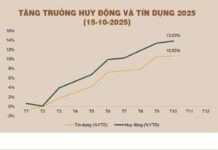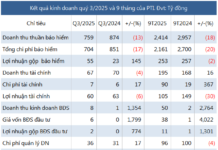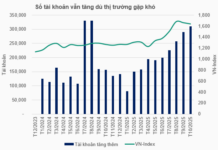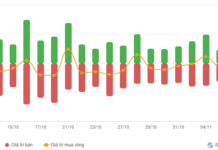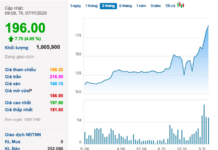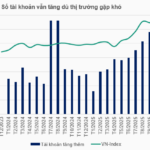Quarterly business results for Q3 2024 are pouring in, but market movements have not shown commensurate reactions. Last week, the VN-Index fell for the first three consecutive sessions, recovered on Thursday, but faltered in the final session. The index also retreated once again after approaching the 1300-point mark. The average matched transaction liquidity on the HoSE floor also did not show any progress and even slightly decreased.
Nevertheless, the strong gain on Thursday helped the VN-Index establish a higher bottom and maintain a narrowing adjustment amplitude, preserving the short-term uptrend since the August 2024 bottom. According to experts, this is a positive technical development as a continuation of the uptrend model is forming, promising a breakthrough opportunity. However, liquidity is still a factor that makes experts cautious, and in fact, the market has had several breakthrough opportunities in the past few weeks but has been unsuccessful.
Commenting on the Q3 2024 business results effect, experts still expect profit information to support the market, and in fact, this is the force that makes the adjustment paces smaller. However, there are also many cases where stocks with good financial reports do not increase in price. According to experts, investors can act depending on their state and strategy. If it is short-term speculation, the poor stock response may be due to “information already reflected in the price,” and the holding ratio should be reduced, especially if using margin. If it is a long-term investment, the good Q3 business results will gradually be reflected in the long-term price trend, especially when Q4 prospects are more positive. Therefore, investors can continue to hold or even buy more when the price retreats.

Technically, continuously creating a higher bottom and moving within a narrowing amplitude are signs similar to the “Ascending Triangle” model. This may indicate a continuation of the uptrend.
Nghiêm Sỹ Tiến
Nguyễn Hoàng – VnEconomy
The market fluctuated unpredictably last week, partly due to the appearance of the derivatives expiration session. VN-Index fell in the first three sessions of the week but recovered in the last two sessions and created a higher bottom than the October peak. Some opinions assessed this as a positive technical signal when the index fluctuated with an increasingly narrow adjustment and continuously hugged the 1300-point region, consolidating the breakthrough opportunity. What are your thoughts on this?
Nguyễn Việt Quang – Director of Business Center 3 Yuanta Hanoi
The index’s adjustment amplitude is getting narrower and narrower, and it is currently hovering around the 1300-point mark. Many people believe this to be a positive development as the index follows the pattern of narrowing trading amplitude. However, the excessive narrowing, coupled with the VN-Index chart resembling a beautiful painting, prompts me to be more cautious than excited. I have a viewpoint: when you climb to the “peak” of a mountain, you will see the most beautiful scenery. Additionally, on Thursday, the index broke through the trend channel formed by the August 5, September 17, and October 7 bottoms, along with the negative developments on Friday. Thus, from my perspective, I remain cautious and have implemented risk management measures by significantly reducing my position. When the market convincingly surpasses 1300, I will consider reinvesting, and it won’t be too late.
Nghiêm Sỹ Tiến – Investment Strategy Specialist, KBSV Securities
Technically, continuously creating a higher bottom and moving within a narrowing amplitude are signs similar to the “Ascending Triangle” model. This may indicate a continuation of the uptrend, following the sideways accumulation sequences with decreasing liquidity and forming higher support points.
After numerous failed tests, the resistance zone around 1300 points is exerting significant pressure on the market’s psychology, causing profit-taking and reduced position actions to dominate when the index reapproaches this level. Nonetheless, with the short-term uptrend being preserved, the probability still favors the scenario of VN-Index successfully conquering the aforementioned resistance threshold.
Lê Đức Khánh – Analysis Director, VPS Securities
The accumulation region revolving around the old peak is narrowing, and the trading amplitude is shortening. The sideways accumulation is meticulous and preparing for a breakthrough opportunity to reach a new peak. I believe this development will likely occur within the next week or, at the latest, the final week of October.
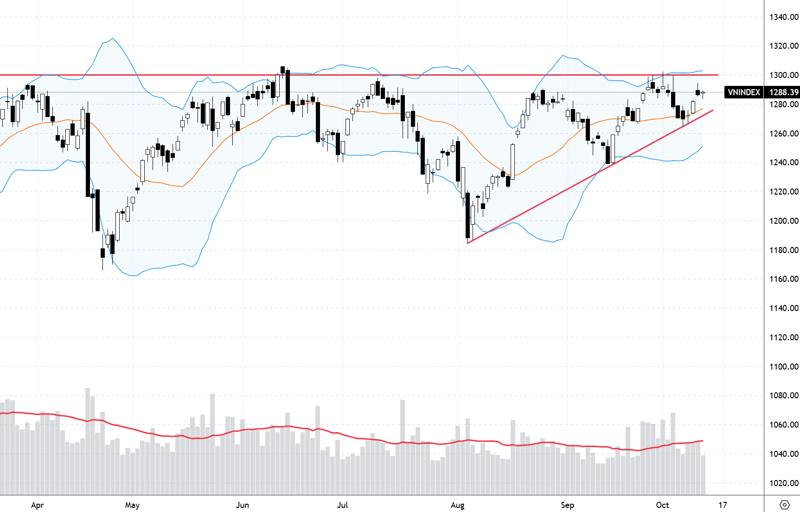
Capital Flow Trend: As the Q3 Earnings Season Begins, Will This Momentum Differ?
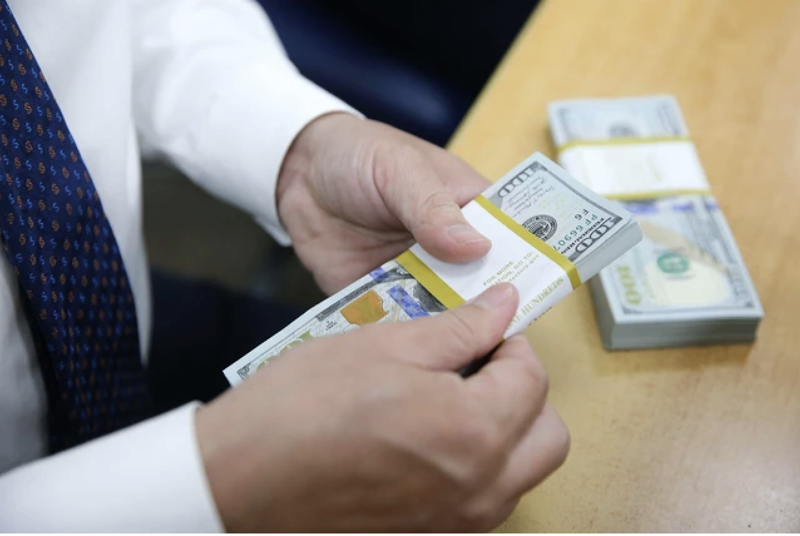
Exchange Rate Surges, State Bank Issues Bills to Absorb Money
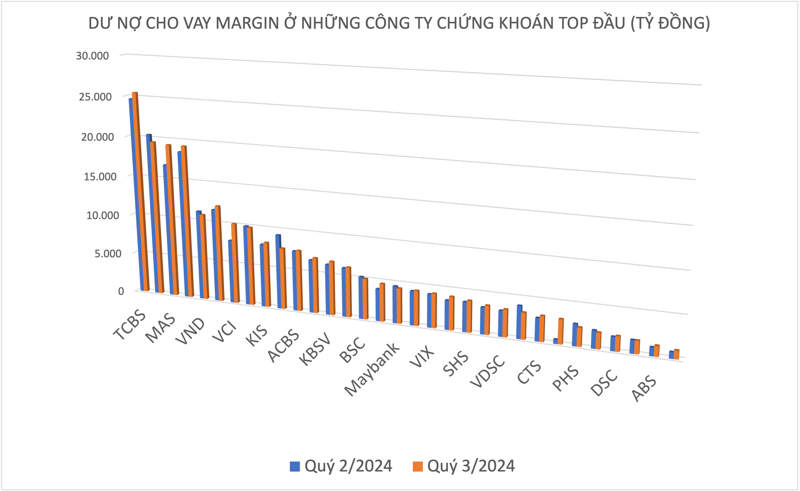
Margin Lending Sets Another Record at VND 235,000 Billion, but It’s “Harmless”
Nguyễn Thị Mỹ Liên – Analysis Department Head, Phu Hung Securities Company
From a technical standpoint, the VN-Index’s fluctuations are forming a VCP pattern with a gradually narrowing amplitude. Typically, this is a positive pattern that provides the possibility of initiating a new uptrend if it breaks through the 1300-point level. However, it is essential to consider that every pattern has a certain success rate. Over the past 1-2 weeks, I have noticed that the market has had a few opportunities for buying forces to participate and contribute to the pattern’s completion, but this has not materialized. If the buying force does not show more positive changes this week, I believe caution is warranted.
Lê Minh Nguyên – Senior Director of Individual Customers, Rong Viet Securities
In the last trading session, the VN-Index closed at the support level of 1285.46 points and is likely to continue testing this support region. If the market maintains this support level in the new trading week, it will consolidate the opportunity to approach the 1300-point region. However, with the current low liquidity, the market is more likely to fluctuate within the 1240-1300 range for accumulation rather than breaking through the 1300-point threshold. In this information trough phase, we cannot expect the market to make a strong breakthrough but rather await gradual accumulation as we approach the end of the year and anticipate more supportive information.
Nguyễn Hoàng – VnEconomy
Last week, you anticipated that capital flows would become more positive this week as business results emerged. However, we have yet to witness a distinct change in liquidity, and transactions have even slightly decreased. Meanwhile, statistics show that individual investors have been net buyers continuously with a substantial scale. It appears that investors remain cautious, or is the market’s capital flow genuinely weakening? How do you assess the demand for margin at this point?
Nguyễn Thị Mỹ Liên – Analysis Department Head, Phu Hung Securities Company
Positive business results will be reflected in stock prices, and capital will flow into those stocks if their valuations remain attractive. Nonetheless, it cannot improve the overall market liquidity. In reality, during the past week, domestic individual investors’ net buying was due to net withdrawal orders from foreign investors. It appears that the buying force remains weak, and investors are cautious as the VN-Index struggles to surpass the 1300 threshold. Therefore, investors should maintain a moderate position and refrain from using margin during this period.

In the current phase, I assess that the demand for margin is moderate, and the available sources are still abundant.
Nguyễn Việt Quang
Nghiêm Sỹ Tiến – Investment Strategy Specialist, KBSV Securities
A significant number of enterprises have announced their Q3 2024 financial results so far. However, overall profits are showing signs of stagnation and even decline in certain sectors. The below-expectation operational results have likely been reflected in the market’s liquidity in recent sessions, with more cautious transactions. These figures may not be negative enough to trigger a sell-off, but they also struggle to generate a substantial buying momentum. Consequently, at least in the first half of Q4 2024, the demand for margin will unlikely witness a significant surge.
Nguyễn Việt Quang – Director of Business Center 3 Yuanta Hanoi
In my observation, many investors maintain a certain stockholding ratio and closely monitor the market’s movements to decide whether to increase or decrease their positions. This also contributes to the market’s lackluster liquidity. In the current phase, I assess that the demand for margin is moderate, and the available sources are still abundant.
Lê Minh Nguyên – Senior Director of Individual Customers, Rong Viet Securities
The business results that have emerged exhibit certain positive aspects, but the market appears to be awaiting more favorable information to attract capital inflows and spur a breakthrough. Currently, individual domestic investors primarily drive the market, while large capital flows remain on the sidelines, observing and awaiting clearer opportunities to participate. The VN-index is fluctuating within a narrowing amplitude, and liquidity has not increased despite the supportive Q3 financial results. This indicates that the demand for margin is also not high at the moment, and short-term trading becomes more challenging.

The accumulation region revolving around the old peak is narrowing, and the trading amplitude is shortening. The sideways accumulation is meticulous and preparing for a breakthrough opportunity to reach a new peak. I believe this development will likely occur within the next week or, at the latest, the final week of October.
Lê Đức Khánh
Lê Đức Khánh – Analysis Director, VPS Securities
During this phase, investors may still require and utilize margin, but it is crucial to reiterate the importance of controlling the number of stocks in their portfolios and being selective. If the opportunity is uncertain, the stock price is favorable, liquidity is high, and the trading style is rapid, using margin can be effective. However, value investors are likely to use it less frequently.
Nguyễn Hoàng – VnEconomy
Foreign capital unexpectedly returned to strong net selling last week, ending the previous four weeks of balanced transactions, with some weeks even recording substantial net buying. Has the exchange rate effect faded, or is foreign capital also taking profits around the 1300-point peak?
Nghiêm Sỹ Tiến – Investment Strategy Specialist, KBSV Securities
The return of foreign capital to net selling could be attributed to the recent sharp rise in exchange rates. Several factors are believed to be the cause, including the increase in the DXY index, the surge in USD foreign currency demand, and the outflow of large amounts of USD from the system. Generally, foreign capital in the stock market is quite sensitive to exchange rate fluctuations, and this issue should also be monitored as the net selling activities of foreign investors may impact the overall market’s trading psychology in the context of limited supportive information.
Lê Minh Nguyên – Senior Director of Individual Customers, Rong Viet Securities
I believe that with the VN-Index approaching the 1300-point threshold amid low liquidity and large capital flows remaining on the sidelines, it is understandable that foreign capital has returned to net selling.
Nguyễn Thị Mỹ Liên – Analysis Department Head, Phu Hung Securities Company
The strong net selling by foreign investors last week was significantly influenced by the rebound in exchange rates, along with escalating geopolitical tensions. The USD Index has been continuously increasing since the end of September and has reached its highest level in over two months. Additionally, the SBV was compelled to intervene to ease the pressure on the exchange rate by issuing bills worth up to VND 12,300 billion after a nearly two-month hiatus.
Foreign capital continues to flow between markets, and I believe foreign investors are adopting a more cautious approach as October presents various variables, such as the US presidential election, the extent of the Fed’s interest rate cuts in 2024, tensions in the Middle East and the Korean Peninsula, and the attractiveness of risky assets like stocks has diminished due to their valuation backdrop.

Over the past 1-2 weeks, I have noticed that the market has had a few opportunities for buying forces to participate and contribute to the pattern’s completion, but this has not materialized. If the buying force does not show more positive changes this week, I believe caution is warranted.
Nguyễn Thị Mỹ Liên
Nguyễn Việt Quang – Director of Business Center 3 Yuanta Hanoi
After a long period of trading in Vietnam, foreign capital has also made strategic adjustments to adapt better to our market. When encountering strong resistance zones or sharp increases in stock prices, such as in the case of bank stocks, it is understandable that they would take profits. Regarding the Fed’s interest rate cuts, foreign capital also needs time to flow between markets.
Lê Đức Khánh – Analysis Director, VPS Securities
The area around the old peak or the rapid increase in bank stock prices, for instance, could lead to increased selling pressure or profit-taking. The reduction in the holding ratio of stocks by foreign investors is also explainable and appropriate in this context.
Nguyễn Hoàng – VnEconomy
Numerous stocks have released their financial results, but their prices have not progressed significantly, and some have even declined last week. How should investors act in this situation?
Nguyễn Việt Quang – Director of Business Center 3 Yuanta Hanoi
It is common for stock prices to remain stagnant or deviate from financial results after the release of such information. This can be explained by the phrase “information has been reflected in the price.” Regarding investor actions, I believe it depends on the stock’s movements and financial results. Here are some examples: if a stock surges to a strong resistance zone before releasing excellent financial results, but its price fails to increase further, consider taking profits; if a stock plunges to a strong support level and releases poor financial results, but the stock price does not drop further, investors can consider buying more or holding the stock, waiting for a rebound to sell…
Nghiêm Sỹ Tiến – Investment Strategy Specialist, KBSV Securities
In






